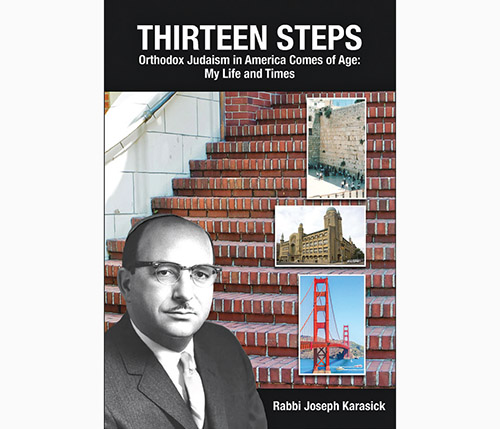
Reviewing “Thirteen Steps: Orthodox Judaism in America Comes of Age: My Life and Times by Rabbi Joseph Karasick. OU Press. Hardcover. 2017. ISBN: 9780999500903. $20.99.
At The Jewish Link office we receive at least one book weekly to review, and multiple email pitches in our inboxes from publicists and publishers eager to have our publication review and tout the latest and greatest book from various authors across the spectrum of Orthodox Judaism. Although we try our best, we are often unable to review or respond positively to every pitch and every book. Having said that, I do try to read almost every book that is sent to me, or at least a chapter or two, at minimum.
However, there are occasionally books that come into our office that I have to read, and in this case, write about in my paper. When Rabbi Joseph Karasick’s 2017 memoir, “Thirteen Steps: Orthodox Judaism in America Comes of Age: My Life and Times,” came to our office before the summer, I was excited to read it. I have met Rabbi Karasick over the years when he visited with his family in Teaneck and I was always impressed by his dignified and aristocratic mien and bearing. I also know his son and daughter-in-law, Rabbi Mark and Linda Karasick, longtime leaders both in our community here in northern New Jersey and well beyond, and think quite highly of them and their extended families. Now, after reading the highly readable and engaging memoir by their proud patriarch who is a living witness and active participant to the growth and success of the U.S. Orthodox community in the post-World War II era, I know where they come from…and it’s quite impressive.
Rabbi Karasick, now 96, was born in Belarus but moved shortly after to San Francisco where he was raised. His father was the local shochet and his grandfather, Rabbi Mendel Katzman, was one of the main Orthodox rabbis in the city. He attended Hebrew school there and finished high school in Los Angeles, attending a yeshiva in the late afternoon after public school. After high school, he enrolled at Yeshiva College, where he served as editor-in-chief of the Commentator in 1942 and stayed for semicha at RIETS, which he received in 1945. After a short stint in the rabbinate in Montreal at the Spanish & Portuguese Synagogue, he returned to New York’s Upper West Side and joined his father-in-law’s watch business, which he helped expand significantly in the ensuing decades. He also threw himself into communal leadership roles, most prominently as the president and chairman of the board of the Orthodox Union from 1966-1978.
Perhaps a defining feature of the chronicle is Rabbi Karasick’s evident pride in his warm and close relationships with both his family, including his wife, Pepa, to whom the book is dedicated, and to his father-in-law, Mr. Yitzchak Wakmann, an important figure in his life, and to his warm, affectionate relationships with the leading rabbinic figures of the era. I enjoyed reading about his exchanges and interactions with YU President Dr. Samuel Belkin, the Lubavitcher Rebbe and the Rav (R’ Joseph B. Soloveitchik) who both formally gave Rabbi Karasick “permission” to leave the rabbinate. He also reveals that he was the primary force responsible for the Rav being invited to serve as the rabbi of the Moriah Shul for eight years (and where the Rav gave a weekly shiur for nearly 30 years). Rabbi Karasick also tells of his role in surveying the scene for his teacher, the Rav, when the Rav was seriously contemplating the position of chief rabbi in 1960, after Rabbi Yitzhak Herzog passed away. He also notes with much satisfaction that as the head of the OU, he played a strong role in helping to establish the Rav as the de facto halachic leader and posek for the national Orthodox community.
On the business side, Rabbi Karasick notes the unique relationship he was able to cultivate with the watchmaker Willy Breitling, and their joint success in developing the Wakmann-Breitling aircraft clock that became the standard clock in the aviation industry for many years.
He writes about the challenges of running a growing business and also being involved in the leadership of the Orthodox Union, to which he was recruited by Moses I. Feuerstein. He contributed extensively to the incredible growth of the Orthodox Union—and the Orthodox community in general—into a major player in the national and international Jewish scene.
Although I have been following the OU for the past 25-30 years, since I came of age in the early 1990s, I was just a decade or so too young to be directly aware of much that Rabbi Karasick retells. By then, Rabbi Karasick was already an elder statesman, as he calls himself in the book’s epilogue, so I never saw him at the full height of his involvement in communal affairs. This memoir helped me fill in some of the gaps I had in the more recent history of the OU.
I finished the book with a strong sense of hakarat hatov to the dedicated communal servant and leader Rabbi Karasick was and as a leader of the generation or two just ahead of my own. I recommend this book to anyone interested in learning more about the personalities and issues faced by postwar Orthodoxy and how they managed to both overcome and ultimately flourish in the half century after World War II. We owe much to that generation, and Rabbi Karasick’s memoir as one of the relatively few remaining stalwarts of that era is an important read.
Yasher koach to Rabbi Karasick for publishing this and kein yirbu to him and his extended family! I wish him and his entire family much continued bracha and hatzlacha!
By Moshe Kinderlehrer,
JLNJ co-publisher and founder










